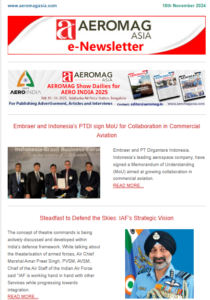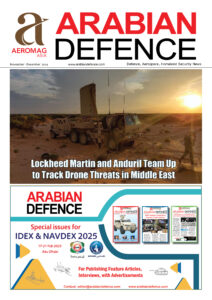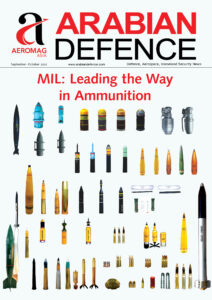
At World Defense Show 2024, Professor General Adam Finlay, a distinguished Australian special forces commander and academic, delivered an insightful presentation on the pivotal role of data and advanced technologies in modern military operations. Zooming in on AI-driven systems used to enhance situational awareness and decision-making capabilities, while also addressing the challenge of cognitive overload that military personnel face in an increasingly data-rich environment.
As the defense industry evolves, militaries are embracing advanced technologies to maximize operational efficiency and enhance personnel experiences. New technologies such as the Internet of Military Things, artificial intelligence, data analytics, and edge computing are redefining military operations. In his presentation titled Advanced Technology Development and the Focus on AI, Professor General Adam Finlay walked attendees through a range of technological transformations and discussed how holistically integrating these technologies can enhance military decision-making.
The Role of Data and AI
Military operations today rely on advanced sensor networks that enhance operations by providing real-time data for improved situational awareness. Artificial intelligence plays a pivotal role in processing this influx of data, essential for analyzing large volumes of information and making real-time decisions. However, the integration of AI into military operations raises ethical questions, particularly regarding its use in decision-making processes. This has sparked an ongoing industry debate on whether AI should make such decisions autonomously or under human supervision, particularly in light of the Geneva Conventions and other rules governing armed conflict.
Within the broader landscape of AI applications, Finlay identifies several key components responsible for transforming military operations. Machine learning enables AI systems to recognize patterns in data and make decisions or predictions without explicit human input. These systems are particularly valuable in generating recommendations or identifying threats based on statistical reasoning, significantly enhancing decision-making capabilities. Natural language processing transforms communication through real-time translation, facilitating seamless collaboration among personnel from diverse linguistic backgrounds—crucial for international military operations. Meanwhile, Generative AI is gaining attention for its ability to create human-like content, including text, images, and audio, applicable in various military contexts from generating reports to simulating scenarios based on vast datasets. Collectively, these technologies embolden the advancement of data-driven AI and pave the way for a more responsive and agile military force.
In addition to AI, cybersecurity and data protection have become critical areas of concern. Finlay notes that AI algorithms are increasingly being employed to penetrate encryption systems, highlighting the need for secure communications and advanced threat detection systems to safeguard sensitive data. This is especially important given the vast amounts of information flowing through military networks.
Interoperability in Modern Military Technologies
All this new technology signifies the vital need for interoperability. With so many devices, platforms, and systems connected to the network, effective information sharing and collaboration across different technologies are essential. There is an ongoing effort to ensure that all these systems work together harmoniously, allowing military personnel access to accurate and timely data.
Edge computing emerges as a transformative solution that minimizes dependency on conventional cloud computing. As Finlay noted, “It’s better for the edge device to do the analytics at the coalface.” Analyzing information locally allows for faster decision-making in critical situations. However, there are instances when sending all data back to a central cloud system for analysis is preferable, considering cloud computing can handle larger data sets. This presents a trade-off: “Do you do it at the edge and send back analyzed information, or do you send it all back to use cloud computing?” Finlay addresses the ongoing tension between bandwidth limitations and the need for real-time analytics in high-stress scenarios.
While these technologies offer significant potential, the true challenge lies in integrating them into a cohesive system. Modern military operates across multiple defense domains—sea, air, land, cyber, and space—each requiring specialized systems for effective communication, navigation, and operational capabilities.
The Challenge of Cognitive Overload
Finlay addresses the biggest challenged faced amidst technological advancements, “When we put all these systems together, we have come to a very, very uncomfortable realization. That in all this high-tech, of all these systems that are being integrated for the human, the weakness is the human. The weakness is the ability of the human to deal with the vast amount of inputs that are coming into his or her brain.”
Despite technological advancements, the biggest challenge remains cognitive overload. Soldiers are often inundated with vast amounts of information from multiple systems, and this can impair their ability to make quick, effective decisions. Finlay stresses how in the face of cognitive overload, complex operations can overwhelm even the most experienced soldiers.
To mitigate this, AI protocols are being developed to manage stress responses in military personnel. When individuals experience cognitive overload, their bodies release cortisol, a hormone linked to stress. Through saliva and blood detectors, AI systems can detect elevated cortisol levels and automatically take over lower-level tasks, allowing personnel to focus on critical decision-making. The AI automatically engages for a time until the cortisol and stress responses have lowered, and they’ve regained full cognitive function.
Finlay concludes by emphasizing the importance of integrating technologies to create a cohesive decision-making system for military personnel. “The totality of them has to be integrated so that personnel can make decisions that are right for the moment with all the inputs at hand, while also accounting for cognitive overload and stress responses.”
A Platform for Innovation
World Defense Show 2024 reaffirmed its status as a leading forum for collaboration, discussion, and innovation within the defense sector. Insights shared by Professor General Adam Finlay to a select audience illustrated the importance of advanced technologies and AI is a vital evolution in the defense landscape. For attendees, this presentation served as a crucial platform for cultivating dialogue and exploring practical solutions to the challenges faced by military personnel, ultimately paving the way for a more effective and responsive defense sector.











